Ex 8.1 class 12 maths ncert solutions | class 12 maths exercise 8.1 | class 12 maths ncert solutions chapter 8 exercise 8.1 | exercise 8.1 class 12 maths ncert solutions | class 12 maths chapter 8 ncert solutions | class 12 chapter 8 maths ncert solutions | applications of integrals class 12
Exercise 8.1 Class 12 Maths NCERT Solutions plays a crucial role in understanding the Applications of Integrals Class 12 chapter. This part of the syllabus deals with calculating areas under curves, an essential concept in calculus. The Class 12 Maths Exercise 8.1 introduces students to problems that involve finding the area bounded by curves and the coordinate axes. The Class 12 Maths NCERT Solutions Chapter 8 Exercise 8.1 provides a step-by-step breakdown of each problem, which makes learning efficient and systematic. Whether you’re searching for Exercise 8.1 Class 12 Maths NCERT Solutions.

class 12 maths exercise 8.1 || ex 8.1 class 12 maths ncert solutions || class 12 chapter 8 maths ncert solutions || applications of integrals class 12 || class 12 maths ncert solutions chapter 8 exercise 8.1 || exercise 8.1 class 12 maths ncert solutions || class 12 maths chapter 8 ncert solutions
Exercise 8.1
1. Find the area of the region bounded by the curve \( y^{2}=x \) and the lines \( x=1, x=4 \) and the x -axis in the first quadrant.
Answer
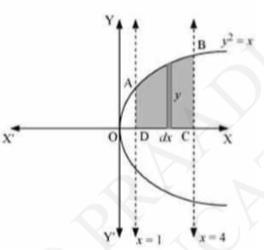
We can see from the figure that the area of the region bounded by the curve \( y^{2}=x \) and the lines \( x=1, x=4 \) is shown by shaded region that is Area ABCD.
Area of \( \mathrm{ABCD}=\int_{1}^{4} y d y=\int_{1}^{4} \sqrt{x} d x \)
\(
=\left[\frac{x^{\frac{3}{2}}}{\frac{3}{2}}\right]_{1}^{4}=\frac{2}{3}\left[(4)^{\frac{3}{2}}-(1)^{\frac{3}{2}}\right]\)
\(=\frac{2}{3}[8-1]\)
\(=\frac{14}{3} \text { units }
\)
2. Find the area of the region bounded by \( y^{2}=9 x, x=2, x=4 \) and the \( x \)-axis in the first quadrant.
Answer
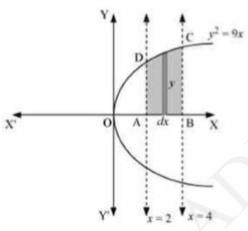
We can see from the figure that the area of the region bounded by the curve \( y^{2}=9 x, x=2, x=4 \) is shown by shaded region that is Area ABCD.
Area of \( \mathrm{ABCD}=\int_{2}^{4} y d y=3 \int_{2}^{4} \sqrt{x} d x \)
\( =3\left[\frac{x^{\frac{3}{2}}}{\frac{3}{2}}\right]_{2}^{4}=2\left[(4)^{\frac{3}{2}}-(1)^{\frac{3}{2}}\right] \)
\( =\frac{2}{3}[8-2 \sqrt{2}] \)
\( =(16-4 \sqrt{2}) \) units
3. Find the area of the region bounded by \( x^{2}=4 y, y=2, y=4 \) and the y -axis in the first quadrant.
Answer
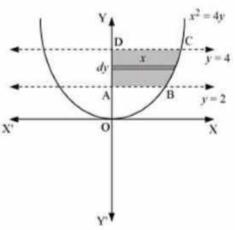
We can see from the figure that the area of the region bounded by the curve \( x^{2}=4 y, y=2, y=4 \) is shown by shaded region that is Area ABCD.
Area of \( \mathrm{ABCD}=\int_{2}^{4} y d y=2 \int_{2}^{4} \sqrt{y} d y \)
\( =2\left[\frac{y^{\frac{3}{2}}}{\frac{3}{2}}\right]_{2}^{4}=2\left[(4)^{\frac{3}{2}}-(2)^{\frac{3}{2}}\right] \)
\( =\frac{4}{3}[8-2 \sqrt{2}] \)
\( =\left(\frac{32-8 \sqrt{2}}{3}\right) \) units
class 12 maths exercise 8.1 || ex 8.1 class 12 maths ncert solutions || class 12 chapter 8 maths ncert solutions || applications of integrals class 12 || class 12 maths ncert solutions chapter 8 exercise 8.1 || exercise 8.1 class 12 maths ncert solutions || class 12 maths chapter 8 ncert solutions
4. Find the area of the region bounded by the ellipse \( \frac{x^{2}}{16}+\frac{y^{2}}{9}=1 \)
Answer

It is given that equation of ellipse is \( \frac{x^{2}}{16}+\frac{y^{2}}{9}=1 \)
We can see that the ellipse is symmetrical about x -axis and y -axis.
\( \therefore \) Area bounded by ellipse \( =4 \times \) Area of OAB
\( \text{Area of} \ \mathrm{ABCD}=\int_{0}^{4} y d x=\int_{0}^{4} 3 \sqrt{1-\frac{x^{2}}{16} d x}=\frac{3}{4} \int_{0}^{4} \sqrt{16-x^{2}} d x \)
\(
=\frac{3}{4}\left[\frac{x}{2} \sqrt{16-x^{2}}+\frac{16}{2} \sin ^{-1} \frac{x}{4}\right]_{0}^{4}\)
\(=\frac{3}{4}\left[2 \sqrt{16-16}+8 \sin ^{-1}(1)-0-8 \sin ^{-1}(0)\right]\)
\(=\frac{3}{4}\left[\frac{8 \pi}{2}\right]\)
\(=\frac{3}{4}[4 \pi]\)
\(=3 \pi\)
Therefore, the required area bounded by the ellipse \( =4 \times 3 \pi=12 \pi \) units.
5. Find the area of the region bounded by the ellipse \( \frac{x^{2}}{4}+\frac{y^{2}}{9}=1 \)
Answer
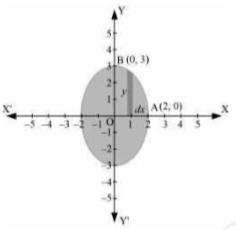
It is given that equation of ellipse is \( \frac{x^{2}}{4}+\frac{y^{2}}{9}=1 \)
We can see that the ellipse is symmetrical about \( x- \) axis and y -axis.
\( \therefore \) Area bounded by ellipse \( =4 \times \) Area of OAB
Area of \( \mathrm{ABCD}=\int_{0}^{2} y d x=\int_{0}^{2} 3 \sqrt{1-\frac{x^{2}}{4}} d x \)
\(=\frac{3}{2} \int_{0}^{2} \sqrt{4-x^{2}} d x\)
\(=\frac{3}{2}\left[\frac{x}{2} \sqrt{4-x^{2}}+\frac{4}{2} \sin ^{-1} \frac{x}{4}\right]_{0}^{2}\)
\(=\frac{3}{2}\left[\frac{2 \pi}{2}\right]\)
\(=\frac{3 \pi}{2}\)
Therefore, the required area bounded by the ellipse \( =4 \times \frac{3 \pi}{2}=6 \pi \) units.
6. Find the area of the region in the first quadrant enclosed by x -axis, line \( x=\sqrt{3} y \) and the circle \( x^{2}+y^{2}=4 \).
Answer
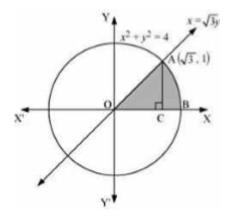
The equations are \( x=\sqrt{3} y \) and the circle \( x^{2}+y^{2}=4 \)
From the figure we can see that the \( x \)-axis is the area \( O A B \) and it is shown by shaded region.
Now, the point of intersection of the line and the circle in the first quadrant is \( (\sqrt{3}, 1) \).
Area \( \mathrm{OAB}= \) Area \( \triangle \mathrm{OCA}+ \) Area ACB
Area of \( \triangle \mathrm{OCA}=\frac{1}{2} \times O C \times A C=\frac{1}{2} \times \sqrt{3} \times 1=\frac{\sqrt{3}}{2} \)
Also,
Area of \( \mathrm{ABC}=\int_{\sqrt{3}}^{2} y d x=\int_{\sqrt{3}}^{2} \sqrt{4-x^{2}} d x \)
\(=\left[\frac{x}{2} \sqrt{4-x^{2}}+\frac{4}{2} \sin ^{-1} \frac{x}{2}\right]_{\sqrt{3}}^{2}\)
\(=\left[\pi-\frac{\sqrt{3} \pi}{2} \sqrt{4-3}-2 \sin ^{-1}\left(\frac{\sqrt{3}}{2}\right)\right]\)
\(=\left[\pi-\frac{\sqrt{3}}{2}-2\left(\frac{\pi}{3}\right)\right]\)
\(=\left[\pi-\frac{\sqrt{3}}{2}-\frac{2 \pi}{3}\right]\)
\(=\left[\frac{\pi}{3}-\frac{\sqrt{3}}{2}\right]\)
Therefore, required area is \( =\frac{\sqrt{3}}{2}+\frac{\pi}{3}-\frac{\sqrt{3}}{2}=\frac{\pi}{3} \) square units.
7. Find the area of the smaller part of the circle \( x^{2}+y^{2}=a^{2} \) cut off by the line \( x=\frac{a}{\sqrt{2}} \).
Answer
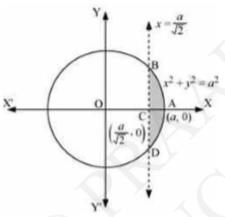
It is given that the area of the smaller part of the circle \( x^{2}+y^{2}=a^{2} \) cut off by the line \( x=\frac{a}{\sqrt{2}} \)
From the figure we can see that the area is ABCDA and it is shown by shaded region.
Now, we can have observed that the area ABCD is symmetrical about x-axis.
Area \( \mathrm{ABCD}=2 \times \) Area \( A B C \)
Area of \( \mathrm{ABC}=\int_{\frac{a}{\sqrt{2}}}^{a} y d x=\int_{\frac{a}{\sqrt{2}}}^{a} \sqrt{a^{2}-x^{2}} d x \)
\(=\left[\frac{x}{2} \sqrt{a^{2}-x^{2}}+\frac{a^{2}}{2} \sin ^{-1} \frac{x}{a}\right]_{\frac{a}{\sqrt{2}}}^{a}\)
\(=\left[\frac{a^{2}}{2}\left(\frac{\pi}{2}\right)-\frac{a}{2 \sqrt{2}} \sqrt{a^{2}-\frac{a^{2}}{2}}-\frac{a^{2}}{2} \sin ^{-1}\left(\frac{1}{\sqrt{2}}\right)\right]\)
\(=\left[\frac{a^{2} \pi}{4}-\frac{a}{2 \sqrt{2}} \cdot \frac{a}{\sqrt{2}}-\frac{a^{2}}{2}\left(\frac{\pi}{4}\right)\right]\)
\(=\frac{a^{2} \pi}{4}-\frac{a^{2}}{4}-\frac{a^{2} \pi}{8}\)
\(=\frac{a^{2}}{4}\left[\pi-1-\frac{\pi}{2}\right]\)
\(=\frac{a^{2}}{4}\left[\frac{\pi}{2}-1\right]\)
\(\Rightarrow \text { Area of ABC }=2\left[\frac{a^{2}}{4}\left(\frac{\pi}{2}-1\right)\right]\)
\(=\frac{a^{2}}{4}\left(\frac{\pi}{2}-1\right)\)
Therefore, required area is \( =\frac{a^{2}}{4}\left(\frac{\pi}{2}-1\right) \) square units
8. The area between \( x=y^{2} \) and \( x=4 \) is divided into two equal parts by the line \( x=a \), find the value of \( a \).
Answer
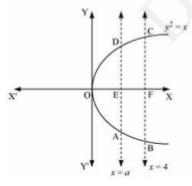
It is given that the area between \( x=y^{2} \) and \( x=4 \) is divided into two equal parts by the line \( x=\mathrm{a} \).
Thus, Area \( \mathrm{OAD}= \) Area ABCD
Now, we can observe that the given area is symmetrical about x -axis.
\( \Rightarrow \) Area OED \( = \) Area EFCD
Now, Area of OED \( =\int_{0}^{a} y d x=\int_{0}^{a} \sqrt{x} d x \)
\( =\left[\frac{x^{\frac{3}{2}}}{\frac{3}{2}}\right]_{0}^{a}=\frac{2}{3}(a)^{\frac{3}{2}} \ldots (1)\)
Area of \( \mathrm{EFCD}=\int_{a}^{4} y d y=\int_{a}^{4} \sqrt{x} d x \)
\(=\left[\frac{x^{\frac{3}{2}}}{\frac{3}{2}}\right]_{a}^{4}=\frac{2}{3}\left[8-(a)^{\frac{3}{2}}\right] \ldots (2)\)
Therefore, from equations (1) and (2), we get,
\( \Rightarrow 2 .(a)^{\frac{3}{2}}=8 \)
\( \mathrm{a}=(4)^{\frac{ 2 }{ 3 }} \)
Hence, the required value of a is \( (4)^{\frac{ 2 }{ 3 }} \).
9. Find the area of the region bounded by the parabola \( y=x^{2} \) and \( y=|x| \).
Answer
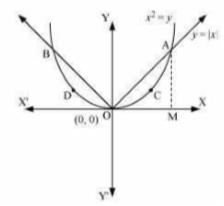
It is given that the area of the region bounded by the parabola \( y=x^{2} \) and \( y=|x| \).
Now, we can observe that the given area is symmetrical about \( y \)-axis.
\( \Rightarrow \) Area \( \mathrm{OACO}= \) Area ODBO
And the point of intersection of parabola, \( y=x^{2} \) and \( y=x \) is \( \mathrm{A}(1,1) \).
Thus, Area \( \mathrm{OACO}= \) Area \( \triangle \mathrm{OAM}- \) Area OMACO
Now, Area of \( \triangle \mathrm{OAM}=\frac{1}{2} \times O M \times A M=\frac{1}{2} \times 1 \times 1=\frac{1}{2} \)
Area of OMACO \( =\int_{0}^{1} y d x=\int_{0}^{1} x^{2} d x \)
\( =\left[\frac{x^{3}}{3}\right]_{0}^{1}=\frac{1}{3} \)
\( \Rightarrow \) Area \( \mathrm{OACO}= \) Area \( \triangle \mathrm{OAM}- \) Area OMACO
\(=\frac{1}{2}-\frac{1}{3}=\frac{1}{6}\)
Therefore, the required area is \( =2 (\frac {1}{6})= \frac {1} {3} \) Answer.
class 12 maths exercise 8.1 || ex 8.1 class 12 maths ncert solutions || class 12 chapter 8 maths ncert solutions || applications of integrals class 12 || class 12 maths ncert solutions chapter 8 exercise 8.1 || exercise 8.1 class 12 maths ncert solutions || class 12 maths chapter 8 ncert solutions
10. Find the area bounded by the curve \( x^{2}=4 y \) and the line \( x= \) \( 4 y-2 \).
Answer
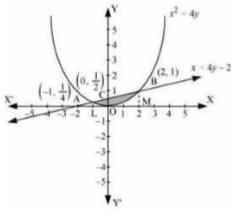
It is given that the area of the region bounded by the parabola \( x^{2}=4 y \) and \( x=4 y-2 \).
Let A and B be the points of intersection of the line and parabola.
Let us calculate the point of intersection of both the curves,
Given: \( x^{2}=4 y \) and \( x=4 y-2 \)
Therefore, putting the value of \( x \), equation of parabola, we get, \( (4 y-2)^{2} \) \( =4 y \)
\( 16 y^{2}+4-16 y=4 y \)
\( 16 y^{2}-20 y+4=0^{\prime} \)
\( 4 y^{2}-5 y+1=0 \)
\( 4 y^{2}-4 y-y+1=0 \)
\( 4 y(y-1)-1(y-1)=0 y=1 \) \(\text{or} \ y=\frac{ 1 }{ 4 } \ \text {Corresponding values of}\) \( x \) are, \( x \) \( =2 \) or \( x=-1 \) Therefore,
Coordinates of point A are \( \left(-1, \frac{1}{4}\right) \)
Coordinates of point B are \( (2,1) \).
Now, draw AL and BM perpendicular to x axis.
We can see that,
Area \( \mathrm{OBCA}= \) \( \text {Area of line - Area of Parabola} \ldots(1)\)
\(=\int_{-1}^{2}\left(\frac{x+2}{4}-\frac{x^{2}}{4}\right) d x\)
\(=\frac{1}{4}\left[\frac{x^{2}}{2}+2 x-\frac{x^{3}}{12}\right]_{-1}^{2}\)
\(=\left(\frac{4}{8}+\frac{2}{2}-\frac{8}{12}\right)-\left(\frac{1}{8}-\frac{1}{2}+\frac{1}{12}\right)\)
\(=\frac{9}{8} \text { sq. units }\)
Hence, the area bounded by the \( x^{2}=4 y \) and the line \( x=4 y-2 \) is \( \frac{9}{8} \) square units.
11. Find the area of the region bounded by the curve \( y^{2}=4 x \) and the line \( x=3 \).
Answer
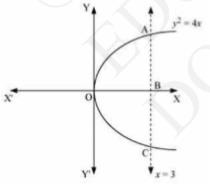
It is given that the region bounded by parabola, \( y 2=4 x \) and the line \( x= \) 3 .
From the figure we can see that the required is OACO.
We can observe that the area OACO is symmetrical about x -axis.
Thus, Area of \( \mathrm{OACO}=2 \) (Area of OAB )
So, Area \( \mathrm{OACO}=2\left[\int_{0}^{3} y d x\right]=2 \int_{0}^{3} 2 \sqrt{x} d x \)
\(=4\left[\frac{x^{\frac{3}{2}}}{\frac{3}{2}}\right]_{0}^{3}=\frac{8}{3}(3)^{\frac{3}{2}}=8 \sqrt{3}\)
Therefore, the required area is \( 8 \sqrt{3} \) square units
12. Area lying in the first quadrant and bounded by the circle \( x^{2}+y^{2}=4 \) and the lines \( x=0 \) and \( x=2 \) is
A. \( \pi \) B. \( \frac{\pi}{2} \) C. \( \frac{\pi}{3} \) D. \( \frac{\pi}{4} \)
A. \( \pi \) B. \( \frac{\pi}{2} \) C. \( \frac{\pi}{3} \) D. \( \frac{\pi}{4} \)
Answer
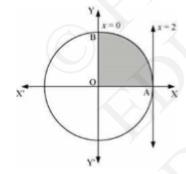
The area bounded by the circle and the lines, \( x=0 \) and \( x=2 \), in the first quadrant is shown by shaded region in above figure.
Area of \( \mathrm{OAB}=\int_{0}^{2} y d x=\int_{0}^{2} \sqrt{4-x^{2}} d x \)
\(=\left[\frac{x}{2} \sqrt{4-x^{2}}+\frac{4}{2} \sin ^{-1} \frac{x}{2}\right]_{0}^{2}\)
\(=2\left(\frac{\pi}{2}\right)=\pi\)
13. Area of the region bounded by the curve \( y^{2}=4 x, y \)-axis and the line \( y=3 \) is
A. 2 B. \( \frac{9}{4} \) C. \( \frac{9}{3} \) D. \( \frac{9}{2} \)
A. 2 B. \( \frac{9}{4} \) C. \( \frac{9}{3} \) D. \( \frac{9}{2} \)
Answer
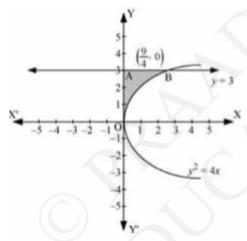
The area bounded by the curve \( y^{2}=4 x, y \)-axis and the line \( y=3 \) is shown by shaded region in above figure.
Thus, Area \( \mathrm{OAB}=\int_{0}^{3} x d y=\int_{0}^{3} \frac{y^{2}}{4} d y \)
\(=\frac{1}{4}\left[\frac{y^{3}}{3}\right]_{0}^{-2}\)
\(=\frac{1}{12}(27)=\frac{9}{4}\)
Therefore, required area is \( =\frac{9}{4} \) square units
